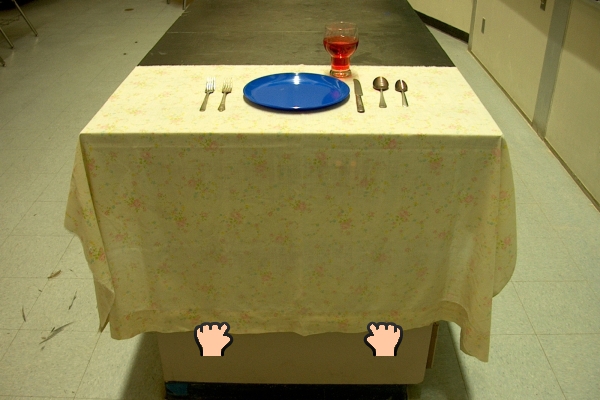This demonstration is similar to a game called “Pull the Rug Out,” originally made in the late 1960s, shown in the photographs below:
This game has a plastic sheet, the “rug,” ten plastic items of various sorts (a ladder, a boat, a man in bathtub, a foot, a hat, a banana, a grasshopper, a surfer on a surfboard, a bed and a pistol) and a spinner. Players take turns spinning the spinner, which tells them which object to add to the stack of objects on the rug. A player may opt to pull the rug out at any time. If he does it without disturbing the pile of objects, he gets a point for each object. If the pile falls, he does not get any points. In our demonstration, the rug is a tablecloth (made of a piece of bedsheet), and the objects are a plate, silverware and a glass, set out as a place setting at a dining table.
If you pull the tablecloth slowly, friction (the subject of a later section) between the plate, silverware and glass causes the objects to move with the tablecloth as you pull it, in which case, if you don’t stop, everything will fall on the floor. If you pull the tablecloth quickly, however, friction cannot provide sufficient force to accelerate the objects appreciably during the short time it takes for you to pull the tablecloth away. Thus, when you pull quickly, you overcome, or “break,” friction, and the items in the place setting move very little, and the place setting stays essentially as it was before. Your ability to do this arises from the inertia of the objects that make up the place setting. Inertia is the tendency of an object to stay at rest, or, if already in straight-line motion, to continue moving along a straight line unless acted on by an external force, and it is proportional to the mass of the object. That is, the greater an object’s mass, the more difficult it is to start it moving from rest or to alter its straight-line motion. The force one must apply to do this is proportional to the mass of the object. In this demonstration, even though some of the objects are not particularly massive, you pull the tablecloth fast enough that in the time it takes you to pull it from under the objects, friction cannot accelerate even the less massive ones significantly, and the place setting stays put.
Newton’s first law, also known as the law of inertia, states, Every body persists in its state of rest or of uniform motion in a straight line unless it is compelled to change that state by forces impressed on it. It is really the second law that makes the connection between inertia and mass (see demonstration 12.33 -- Vertical Atwood’s machine). Though the demonstrations in this category do not really illustrate this, it is worth making two important points regarding Newton’s first law. First, an object can have several forces acting on it simultaneously, but if their resultant is zero, it stays at rest or moves at a constant velocity, depending on what it was doing when those forces were applied. As long as there is no net force on the object, it continues as it was. Second, implicit in this law is the idea of reference frames. If an object is not near any other object, and thus not subject to any external forces, it is possible to find a set of reference frames such that, when observed from any of those reference frames, the object appears to have no acceleration; it moves in a straight line at constant velocity or is standing still. Thus, in such reference frames, the law of inertia holds, and they are known as inertial frames. Probably because Galileo formulated the law of inertia on which Newton based his first law of motion, such reference frames are also known as Galilean reference frames.
A note about technique:
This demonstration is a lot of fun, and the class invariably finds it quite entertaining, and also rather impressive. It is also quite easy to do, but because of the nature of the tablecloth, to keep it from bunching, or from wrinkling in such a way as to disturb the place setting, it is important that you pull from the proper spots at the edge of the cloth, and at the right angle with respect to the tabletop. Grasp the edge of the tablecloth somewhere between one-quarter and one-third of the way in from each side, approximately as shown by the hand icons in the photograph above. Hold the edge out so that the end of the tablecloth makes a roughly 45-degree angle to the tabletop. Pull quickly at roughly 45 degrees – et voilà!
An interesting twist:
If you will be discussing friction, an interesting puzzle to mention (and, perhaps, have the class work out, and discuss) is the following: given the coefficient of (sliding) friction between an item and the tablecloth, its initial distance from the edge of the table, and the distance from the end of the tablecloth (underneath the object) to the edge of the table, how fast would you have to pull the tablecloth so that in the time it takes to pull the tablecloth completely from under the object, the object is just at the edge of the table (and so does not get pulled over the edge)? If you take too long to pull the tablecloth, you pull the object over the edge. If you pull the whole tablecloth through in too short a time, then you leave the object too far from the edge. (Thanks to Prof. Dirk Bouwmeester for suggesting this problem to me.)
A rough measurement with the (melamine?) plate and the tablecloth gives μs = 0.19 and μk = 0.16. I made these measurements by placing a 7.3-kg block on top of the plate (fixing one end with black tape so that it would not slide relative to the plate), whose mass is 173 g. I fixed the edge of the tablecloth with lead bricks, and then dragged the block with a spring scale. The normal force on the plate was about 73.2 N, and the force to break static friction and that to maintain sliding were, approximately, 13.7 N and 11.85 N, respectively. These are averages of five measurements. Dividing them by the normal force gives the coefficients above. Coefficients for the glass and silverware are probably not much different from these.
References:
1) Resnick, Robert and Halliday, David. Physics, Part One, Third Edition (New York: John Wiley and Sons, 1977), p. 75.
2) Kittel, Charles; Knight, Walter D. and Ruderman, Malvin A. Mechanics/Berkeley Physics Course — Volume 1 (New York: McGraw-Hill Book Company, 1965), pp. 59-60.


